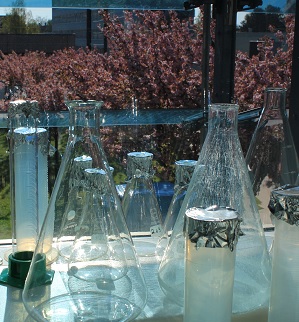Forschungsschwerpunkte (ÖPB bis 2009)
der Abteilung Ökologische und Pflanzen-Biochemie
Intracellular heavy metal detoxification by thiol peptides and proteins in plants and fungi
Research in the division of Ecological and Plant Biochemistry is focussed on the interaction of plants and fungi with biotic and abiotic environment, especially in aquatic systems. Biochemical and molecular biological studies on model systems might lead to understanding of ecological relevant stress situations caused by heavy metals and organics.
The findings are important for assessment and characterization of potentially toxic xenobiotics for delicate ecosystems. High resolution bioanalytic procedures permit to define stress response in organisms and to detect stress metabolites.
Several organisms are adapted to live in heavy metal polluted environments (e.g. the former copper mining district Mansfelder Land, Central Germany) only by a strict regulation of the cellular heavy metal homeostasis, which includes the biosynthesis of heavy metal binding substances, subcellular metal compartmentation and strictly regulated metabolism.
In plants and fungi heavy metals induce enzymatic biosynthesis of complexing thiol peptides (e.g. phytochelatines, glutathione) and proteins (metallothioneins). Investigations on stress response of mosses as model organisms for higher plants are performed on a single cell level by capillary extraction and laser capture microdissection. Our research has shown a unique effect of heavy metals: an increase of the glutathione pool in mosses, which is in contrast to higher plants where heavy metals normaly leads to reduced glutathione pools and increased synthesis of phytochelatins. Using analytical electron raster microscopy on cells of the aquatic biomonitor moss Fontinalis antipyretica we were able to show evidence for cytoplasmatic Cd-(bis)glutathionate complexes.
To expand and deepen research, especially on regulation of the assimilatoric sulfate reduction under heavy metal stress with molecular biological methods, sterile cultures of Physcomitrella patens, Marchantia polymorpha and several Chlamydomonas reinhardii wildtype strains has been established. While under heavy metal stress C. reinhardii synthesizes higher amounts of phytochelatins in P. patens no phytochelatins can be found. Both P. patens and C. reinhardii are (nearly) completely sequenced. Thus, we were able to generate an EST database for all enzymes, which are involved in assimilatoriy sulfate reduction and those for related thiol peptide synthesis.
Fungi essentially determine the ecological performance potential of distinct habitats. Aquatic hyphomycetes as important links in food webs have been isolated from highly heavy metal polluted surface water from copper shale mining area Mansfelder Land (Germany). These isolates are used for examination of tolerance mechanisms of “complex” adapted organisms. Two Heliscus lugdunensis isolates (possibly ecotypes) show physiological and biochemical differences: Cadmium stress increases cellular glutathione content and induces the synthesis of additional thiol peptides. HPLC, electrospray ionization mass spectrometry, and Edman degradation confirmed the synthesis of a novel small metallothionein as well as phytochelatin 2, which are now under intensive characterization.






